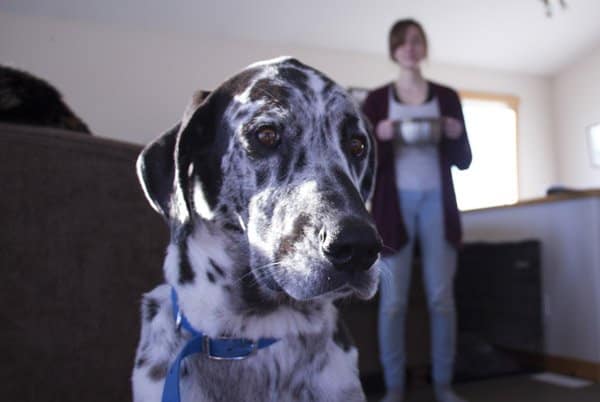The Three Stages of Handling Deafness in Dogs: Suspicion, Confirmation, and Adjustment

Dogs can go deaf for a variety of different reasons. Like humans, dogs can suffer from congenital deafness, being born deaf, or they can go deaf at some point in their lives. Dogs that are prone to frequent ear infections are at higher risk of deafness. An injury to the ear could leave a dog more likely to become deaf, or they could go deaf from old age.
White dogs are more likely to be born deaf than dogs of other colours. But no matter the cause of deafness, deaf dogs are completely capable of leading full and happy lives.
Let’s follow our friend Buddy and his owner as they navigate through the three stages of handling deafness.
Have you noticed any of these three signs?
- Is Buddy startled when you approach him? Usually dogs hear their owners coming. If you’re walking up to Buddy in the morning, and he doesn’t seem to realize you’ve approached and gets startled, a possible explanation could be deafness. It could be that you just caught him in the middle of a nap. But if it always seems like you’re sneaking up on Buddy, then something might be up.
- Has Buddy stopped coming when you call him? If you’re used to Buddy having turn-on-a-dime recall, but you’ve noticed he’s getting more and more oblivious to you, and it doesn’t seem like he’s listening when you call him that could be a sign of deafness. Some owners think their dogs are just being willful for one reason or another, maybe old age. And while that is possible, large personality changes can be signs of a bigger issue.
- Has Buddy stopped barking when people come to the door? If Buddy has always been known to bark or get excited when someone comes to the door, but now he’s just letting any old person into the house, that’s another possible sign his hearing might be impaired.
It seems like something is definitely up. How can we tell for sure if Buddy has gone deaf?
At The Winnipeg Humane Society, a common test we perform is called “the bowl test.” It’s a test you can do easily at home.
Make sure Buddy is facing the other way, and can’t see you. Grab a metal bowl, and drop it on the floor from standing height. It’s going to make a loud noise. If Buddy doesn’t react at all, that’s a pretty big sign he actually couldn’t hear it.
You can perform the same test with other sounds. For example, with Buddy still facing away from you, grab his favourite squeaky toy and squeak it. Did he react?
There is a technical test you can’t perform at home, called a BEAR test (Brain Evoked Auditory Response Test.) There are virtually no risks associates with a BEAR test. Electrodes are attached to a dog’s head to monitor brain activity while a series of sounds are played for the dog. This test can tell which ear is hearing how much, and can give a definitive diagnosis based in science.
It’s official; Buddy is deaf. What do you do now?
Dogs learn just as much, if not more, from our body language as they do from our words. When you’re telling Buddy to “sit” or “stay,” he’s watching your body language while he’s listening to what you’re saying.
Focus on body language when you’re adjusting to interacting with Buddy now that he’s deaf. Think about what kinds of body language you use when you’re giving Buddy commands, and exaggerate those movements from now on.
There’s a myth that deaf dogs are more likely to be aggressive because they could get startled more easily. However, this is not true. Deaf dogs are no more likely to be aggressive than dogs that can hear.
Remember, Buddy can have the same quality of life without his hearing as he did before he went deaf!
Keep loving Buddy and being his best friend, he’ll know how you feel, even if he can’t hear you say it.

